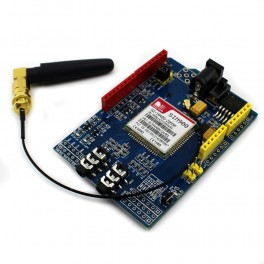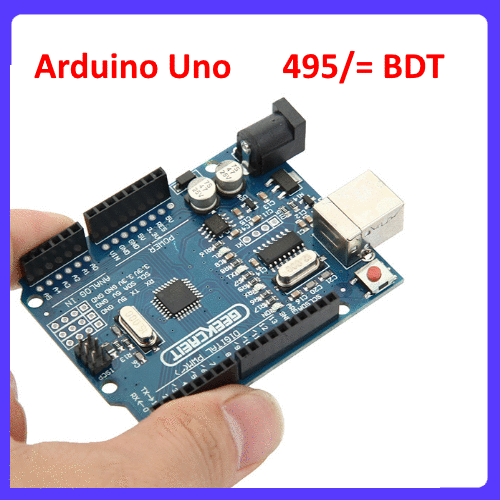The GPRS Shield provides you a way to use the GSM cell phone network to receive data from a remote location. The shield allows you to achieve this via any of the three methods:
- Short Message Service
- Audio
- GPRS Service
The GPRS Shield is compatible with all boards which have the same form factor (and pinout) as a standard Arduino Board. The GPRS Shield can be configured and controlled through UART by simple AT commands. Based on the SIM900 module from SIMCOM, the GPRS Shield is like a cell phone. Besides the communications features, the GPRS Shield has 12 GPIOs, 2 PWMs and an ADC.
Features
- Based on SIMCom‘s SIM900 Module
- Quad-Band 850 / 900/ 1800 / 1900 MHz - would work on GSM networks in all countries across the world.
- Control by AT commands - Standard Commands: GSM 07.07 & 07.05 | Enhanced Commands: SIMCOM AT Commands.
- Short Message Service - so that you can send small amounts of data over the network (ASCII or raw hexadecimal).
- Embedded TCP/UDP stack - allows you to upload data to a web server.
- Speaker and Headphone jacks - so that you can send DTMF signals or play recording like an answering machine.
- SIM Card holder and GSM Antenna - present onboard.
- 12 GPIOs, 2 PWMs and an ADC (all 2.8 volt logic) - to augment your Arduino.
- Low power consumption - 1.5mA(sleep mode)
- Industrial Temperature Range - -40°C to +85 °C
Application Ideas
- M2M (Machine 2 Machine) Applications - To transfer control data using SMS or GPRS between two machines located at two different factories.
- Remote control of appliances - Send SMS to turn on or off your washing machine at home while you are at your office.
- Remote Weather station or a Wireless Sensor Network - Make it with Seeeduino Stalker and create a sensor node which is capable of transferring sensor data (like from a weather station - temperature, humidity etc.) to a web server (like pachube.com).
- Interactive Voice Response System - Couple the GPRS Shield with an MP3 Decoder and DTMF Decoder (besides an Arduino) to create an Interactive Vocice Response System (IVRS).
- Vehicle Tracking System - Couple the GPRS Shield with an Arduino and GPS module. Then install it in your car and publish your location live on the internet. It can be used as a automotive burglar alarm.
Cautions
- Make sure your SIM card is unlocked.
- The product is provided without an insulating enclosure. Please observe ESD precautions specially in dry (low humidity) weather.
- The factory default setting of the GPRS Shield UART is 19200 bps 8-N-1. (It can be changed by AT commands).
- When using GPRS Shield with Seeeduino Stalker, please remember to dismount the OK_READ Jumper (i.e. open it). This will disconnect the Battery Charger IC’s OK pin from the microcontrollers Digital Pin 7 and hence allow unhindered communication with GPRS Shield by using NewSoftSerial Library.
Specifications
For SIM900’s Specifications, please refer this PDF file: SIM900_SPEC.pdf
| Item | Min | Typical | Max | Unit |
|---|
| Voltage | 4.8 | 5.0 | 5.2 | VDC |
|---|
| Current | / | 50 | 450 | mA |
|---|
| Dimension(with antenna) | 110x58x19 | mm |
|---|
| Net Weight | 76±2 | g |
|---|
Compatibility
We have produced a lot of extension boards that can make your platform board more powerful, however not every extension board is compatible with all the platform boards, we use a table to illustrate how are those boards compatible with platform boards.
Note
Please note that “Not recommended” means that it might have chance to work with the platform board however requires extra work such as jump wires or rewriting the code. If you are interested in digging more, welcome to contact with [email protected].
Click to see full picture
Interface Function

- Power select - select the power supply for GPRS shield(external power or 5v of arduino)
- Power jack - connect to external 4.8~5VDC power supply
- Antenna interface - connect to external antenna
- Serial port select - select either software serial port or hardware serial port to be connected to GPRS Shield
- Hardware Serial - D0/D1 of Arduino/Seeeduino
- Software serial - D7/D8 of Arduino/Seeeduino only
- Status LED - tell whether the power of SIM900 is on
- Net light - tell the status about SIM900 linking to the net
- UART of SIM900 - UART pins breakout of SIM900
- Microphone - convert sound into an electrical signal
- Speaker - convert electrical signal into sound
- GPIO,PWM and ADC of SIM900 - GPIO,PWM and ADC pins breakout of SIM900
- Power key - power up and down for SIM900
Pins usage on Arduino
- D0 - Unused if you select software serial port to communicate with GPRS Shield
- D1 - Unused if you select software serial port to communicate with GPRS Shield
- D7 - Used if you select software serial port to communicate with GPRS Shield
- D8 - Used if you select software serial port to communicate with GPRS Shield
- D9 - Used for software control the power up or down of the SIM900
- Note: A4 and A5 are connected to the I2C pins on the SIM900. The SIM900 cannot be accessed via the I2C .
Getting Started
Light Status
| LED | State | Function |
|---|
| Status | Off | Power Off |
| On | Power On |
| Netlight | Off | SIM900 is not working |
| 64ms On/800ms Off | SIM900 does not find the network |
| 64ms On/3000ms Off | SIM900 finds the network |
| 64ms On/300ms Off | GPRS communication |
Hardware installation
Insert an unlocked SIM card into SIM Card Holder - 6 Pin Holder for SIM Cards. Both 1.8 volts and 3.0 volts SIM Cards are supported by SIM900 - voltage type of the SIM card is automatically detected.
- Insert the SIM Card into the holder

- Lock the SIM Card Holder

Make sure the antenna pad buckled properly - A miniature coaxial RF connector is presented on the GPRS Shield board to connect a GSM Antenna. The connector presented on the GPRS Shield is called a U.FL connector. The GSM The Antenna being attached on the GPRS Shield has an SMA connector (and not an RP-SMA connector) on it. A patch cord is also supplied with the GPRS Shield to interface the antenna to the board. The connection topology is shown in the diagram below:


- Power supply for GPRS shield - Select power source through the switch on board, you can select the 5V power supply from arduino or external power supply. Select the 5V source from Arduino as the following picture:

- Config Communication port- The GPRS shield can be controlled via Hardware serial port of Arduino or Software serial port, Select the Software serial port with the jumpers:
| GPRS communicate with arduino by software serial | GPRS communicate with arduino by hardware serial |
|---|
 |  |
- Plug into Arduino UNO R3 - The GPRS Shield, like any other well designed shield, is stackable as shown in the photo below.
- GPRS Shield + Arduino UNO R3

Power up and power down
Hardware trigger Press the power key for about 2 seconds to power up or power down.
Software trigger You can power up/down the shield through D9 pin of Arduino by adding software triggering in your firmware.
Note
The JP for pin 9 on the shield must be soldered in order to use software power up/down.

As the timing of turn on/off , a >1s pulse was needed to trigger the turning, and a >3.2s delay was needed to get the timing stable. The following code in your firmware is required to turn on / off the shield without pressing the button:
void powerUpOrDown() { pinMode(9, OUTPUT); digitalWrite(9,LOW); delay(1000); digitalWrite(9,HIGH); delay(2000); digitalWrite(9,LOW); delay(3000); }
Getting Started - Fun with AT Commands
The GPRS Shield comes with all the accessories that you need to get started with sending data over the GSM network except an Arduino board and a GSM SIM Card. If you want to make voice calls, you would also require a headset with microphone.
Step 1: Creating a test setup for the GPRS Shield
As you received your GPRS Shield, what would be the first thing you want to do with it? Send out a text (SMS)? or call up someone (headset required)? You can do all of these by talking to the GPRS Shield through AT Commands - which is a special language that it understands. AT Commands are simple textual commands sent to the GPRS modem over its serial interface (UART), so you can use any serial terminal software to communicate with it.
Note
Almost all the AT commands should be sent by following with carriage return and you need to select the “+CR”option in the serial port terminal.
To do experiment with AT commands, you would require a way to power up and communicate with your GPRS Shield. The best way to do this using an Arduino Duemilanove board described below. The same steps are applicable for Seeeduino or Seeeduino Stalker.
- Follow the previous hardware installation steps to set up the hardware system;
- Make sure the GPRS_TX & GPRS_RX jumpers on the GPRS Shield are mounted in SWSerial position - so GPRS_TX will be connected to D7(RX) and GPRS_RX to D8(TX).
- Connect the Arduino Duemilanove (or Seeeduino) to your computer by a USB cable.
- The ATmega328P microcontroller on Duemilanove board has only one UART which is used for communicating with the PC. What we need is an Arduino Sketch running inside the ATmega328P that would emulate a second serial port (UART) by using software serial on the digital pins D8 and D7. All the communication will go through the software serial port and the actual hardware serial port. By doing this, all the data coming from the computer (connected to the actual hardware UART) would be routed to the GPRS Shield (connected to software UART). Then we would be able to issue AT commands to control the GPRS Shield. The block diagram outlining this scheme is shown below.

For developing such a program, we need to use the SoftwareSerial library. Here is the demo code.
//Serial Relay - Arduino will patch a //serial link between the computer and the GPRS Shield //at 19200 bps 8-N-1 //Computer is connected to Hardware UART //GPRS Shield is connected to the Software UART SoftwareSerial GPRS(7, 8); unsigned char buffer[64]; // buffer array for data recieve over serial port int count=0; // counter for buffer array void setup() { GPRS.begin(19200); // the GPRS baud rate Serial.begin(19200); // the Serial port of Arduino baud rate. } void loop() { if (GPRS.available()) // if date is comming from softwareserial port ==> data is comming from gprs shield { while(GPRS.available()) // reading data into char array { buffer[count++]=GPRS.read(); // writing data into array if(count == 64)break; } Serial.write(buffer,count); // if no data transmission ends, write buffer to hardware serial port clearBufferArray(); // call clearBufferArray function to clear the storaged data from the array count = 0; // set counter of while loop to zero } if (Serial.available()) // if data is available on hardwareserial port ==> data is comming from PC or notebook GPRS.write(Serial.read()); // write it to the GPRS shield } void clearBufferArray() // function to clear buffer array { for (int i=0; i<count;i++) { buffer[i]=NULL;} // clear all index of array with command NULL }
- Upload the sketch to the Arduino board.
- Download and download serial tool if you don’t have one. Choose the correct COM port for Arduino, and set it to operate at 19200 8-N-1 and then click “Open COM”.
- You can power on or off SIM900 by pressing the button about 2 second. After power on, the red LED will be on, the green one beside it will blink and the shield has found the net if it blinks every 3 seconds. Here is the Power_on_and_off button.

Also, you should see messages from the shield such as RDY +CFUN: 1 +CPIN: READYCall Readyin the serial monitor. If you can not see the messages in the serial monitor, you should click the “send new” option that will add carriage return at the end of AT command and then send AT command “AT+IPR=19200” to set the baud rate of the SIM900.

Note that the baud rate of GPRS shield and the Arduino’s serial port should be the same before you setting the GPRS shield’s baud rate.
- Now, click “send new” option, then type and send “AT” (without the quotes) to the Arduino board. The GPRS Shield should respond by sending an “OK” back. This means that you have successfully configured your GPRS Shield. You can play around with various AT Commands now. (If you are using the readily available Serial Monitor in the Arduino IDE, you should set the line ending to “Carriage return” along with a baud rate of 19200).
Step 2: Sending a text message (SMS)
Now that our test setup is ready, let’s play around with some AT Commands manually before moving on to program the Arduino to do this. Let’s try sending an SMS to start.
- Create the setup as described in Step 1 above.
- Through your serial terminal software, send AT+CMGF=1 and press the Enter key. The GPRS Shield can send SMSes in two modes: Text mode and PDU (or binary) mode. Since we want to send out a human readable message, we will select the text mode. The GPRS Shield will respond with an OK.
- Click “send new” option and send AT+CMGS=”+918446043032”. This will instruct the GPRS Shield to start to accept text for a new message,numbers mean the specified phone number(replace the number with the phone number of the target phone). The GPRS Shield will send a ‘>‘ to remind you to type the message. Please note that phone numbers in any AT Command must follow E.123 format format.

- Start to type your message, after finishing the typing, click “send hex” option and then send a hex: 1A. The modem will accept the message and respond with an OK. A few moments later, the message should be received on the handset whose number you had specified.You can refer to the picture below.

Note
If you follow steps as specified above, you aren’t able to receive the message on the target handset, then it might be that you need to set the SMS Message Center number.
Send the command AT+CSCA=”+919032055002” and press the Enter Key. Send this command in between the AT+CMGF and AT+CMGS commands. Replace the phone number specified in the command above with the SMS Center number of your GSM Service Provider.
The message center number is specific to each service provider (for example +919032055002 is the message center number for Tata DoCoMo, Pune, India). You can get the message center number by calling up the customer center of the GSM Service Provider and asking them for it.
Step 3: Exploring further
Now that you have gotten a taste of how the AT Commands work, you can try out other commands before moving on to develop sketches for Arduino by using the GPRS Shield.
This involves to create a sketch for sending out these same sequence of AT Commands (on your behalf) out the serial port to the GPRS Shield to perform the same task of sending and SMS, making a call or sending data over a GPRS connection.
You can go through the AT Commands reference manual to figure out the sequence of commands. If you develop an Arduino sketch, you find that the GPRS Shield doesn’t act as what you expect, then you will need to check your AT Commands and their sequence. To do this, reload the serial relay sketch attached above in the getting started section into ATmega328P and type out the AT Commands manually and check the output. The responses sent back by the GPRS Shield will help you debug the AT Command sequence.
The program was developed on a Windows PC.AVRStudio4 was used as the IDE and WinAVR was used as the compiler. The ZIP file contains an AVRStudio4 Project. The C compiler (WinAVR) will generate an Intel Hex (.hex). To upload this .hex file into an Arduino board outside of Arduino IDE would require a program which is able to communicate with the Arduino boards bootloader. XLoader is such a program which runs on Windows can upload .hex files generated by various compiler into an Arduino Board.
SoftwareSerial library Notes
With Arduino 1.0 you should be able to use the SoftwareSerial library included with the distribution (instead of NewSoftSerial). However, you must be aware that the buffer reserved for incoming messages are hardcoded to 64 bytes in the library header, “SoftwareSerial.h”:
define _SS_MAX_RX_BUFF 64
This means that if the GPRS module receive more data than the buffer, you are likely to lose it with a buffer overflow! For instance, reading out an SMS from the module with “AT+CMGR=xx” (xx is the message index), you might not even see the message part because the preceding header information (like telephone number and time) takes up a lot of space. The fix seems to be to manually change _SS_MAX_RX_BUFF to a higher value (but reasonable so you don’t use all your memory!)
The Softwareserial library has the following limitations (taken from arduino page). If use multiple software serial ports, only one can receive data at a time. This means that if you try to add another serial device such as grove serial LCD you may get communication errors unless you craft your code carefully.
A Simple Source Code Examples
The below demo code is for the Xduino to send SMS message, dial a voice call, submit a http request to a website and upload data to the pachube. It has been tested on Arduino Duemilanove and also works on any compatible platforms, please note that this sketch uses the software UART of ATmega328P. please follow the below steps to run this sketch.
- Remove GPRS Shield, download this sketch into your Arduino.
- Disconnect the Xduino from USB port to remove power source.
- Set the Serial Port jumpers on the GPRS Shield in SWserial position, to use the Soft Serial port of Arduino.
- Connect the antenna to the GPRS Shield and insert the SIM Card.
- Mount the GPRS Shield on Arduino.
- Connect the Arduino to the computer by USB, and fire up your favorite serial terminal software on computer, choose the COM port for Arduino, set it to operate at 19200 8-N-1.
Type command in the terminal to execute different function, there are 4 functions in the demo:
- a. If you input ‘t’, the demo will send a SMS message to another cellphone which you define(you need set the number in the code);
- b. If you input ‘d’, the program will dial a call to the other cellphone that you define(you need set the number in the code);
- c. If you input ‘h’, it will submit a http request to a web that you want to access(it need you set the web address in the code), it will return a string from the website if it goes correctly;
- d. If you input ‘s’, it will upload the data to the pachube(for detail you can refer to the explanation in the code). I strongly recommend you input ‘h’ before input ‘s’, because uploading data to the pachube need do some setting, after executing the function of submit a http request, the setting will be executed.
If the program returns error in the terminal after you typing the command, don’t worry, just try input the command again.
#include <SoftwareSerial.h> #include <String.h> SoftwareSerial mySerial(7, 8); void setup() { mySerial.begin(19200); Serial.begin(19200); delay(500); } void loop() { if (Serial.available()) switch(Serial.read()) { case 't': SendTextMessage(); break; case 'd': DialVoiceCall(); break; case 'h': SubmitHttpRequest(); break; case 's': Send2Pachube(); break; } if (mySerial.available()) Serial.write(mySerial.read()); } void SendTextMessage() { mySerial.print("AT+CMGF=1\r"); delay(100); mySerial.println("AT + CMGS = "+86138xxxxx615""); delay(100); mySerial.println("A test message!"); delay(100); mySerial.println((char)26); delay(100); mySerial.println(); } void DialVoiceCall() { mySerial.println("ATD + +86138xxxxx615;"); delay(100); mySerial.println(); } void SubmitHttpRequest() { mySerial.println("AT+CSQ"); delay(100); ShowSerialData(); mySerial.println("AT+CGATT?"); delay(100); ShowSerialData(); mySerial.println("AT+SAPBR=3,1,"CONTYPE","GPRS""); delay(1000); ShowSerialData(); mySerial.println("AT+SAPBR=3,1,"APN","CMNET""); delay(4000); ShowSerialData(); mySerial.println("AT+SAPBR=1,1"); delay(2000); ShowSerialData(); mySerial.println("AT+HTTPINIT"); delay(2000); ShowSerialData(); mySerial.println("AT+HTTPPARA="URL","www.google.com.hk""); delay(1000); ShowSerialData(); mySerial.println("AT+HTTPACTION=0"); delay(10000); ShowSerialData(); mySerial.println("AT+HTTPREAD"); delay(300); ShowSerialData(); mySerial.println(""); delay(100); } void Send2Pachube() { mySerial.println("AT+CGATT?"); delay(1000); ShowSerialData(); mySerial.println("AT+CSTT="CMNET""); delay(1000); ShowSerialData(); mySerial.println("AT+CIICR"); delay(3000); ShowSerialData(); mySerial.println("AT+CIFSR"); delay(2000); ShowSerialData(); mySerial.println("AT+CIPSPRT=0"); delay(3000); ShowSerialData(); mySerial.println("AT+CIPSTART="tcp","api.cosm.com","8081""); delay(2000); ShowSerialData(); mySerial.println("AT+CIPSEND"); delay(4000); ShowSerialData(); String humidity = "1031"; String moisture = "1242"; String temperature = "30"; String barometer = "60.56"; mySerial.print("{"method": "put","resource": "/feeds/42742/","params""); delay(500); ShowSerialData(); mySerial.print(": {},"headers": {"X-PachubeApiKey":"); delay(500); ShowSerialData(); mySerial.print(" "_cXwr5LE8qW4a296O-cDwOUvfddFer5pGmaRigPsiO0"); delay(500); ShowSerialData(); mySerial.print("jEB9OjK-W6vej56j9ItaSlIac-hgbQjxExuveD95yc8BttXc"); delay(500); ShowSerialData(); mySerial.print("Z7_seZqLVjeCOmNbEXUva45t6FL8AxOcuNSsQS"},"body":"); delay(500); ShowSerialData(); mySerial.print(" {"version": "1.0.0","datastreams": "); delay(500); ShowSerialData(); mySerial.println("[{"id": "01","current_value": "" + barometer + ""},"); delay(500); ShowSerialData(); mySerial.println("{"id": "02","current_value": "" + humidity + ""},"); delay(500); ShowSerialData(); mySerial.println("{"id": "03","current_value": "" + moisture + ""},"); delay(500); ShowSerialData(); mySerial.println("{"id": "04","current_value": "" + temperature + ""}]},"token": "lee"}"); delay(500); ShowSerialData(); mySerial.println((char)26); delay(5000); mySerial.println(); ShowSerialData(); mySerial.println("AT+CIPCLOSE"); delay(100); ShowSerialData(); } void ShowSerialData() { while(mySerial.available()!=0) Serial.write(mySerial.read()); }
FAQ
Here is the GPRS Shield FAQ that list the frequently asked questions, please read it before use:
Why does GPRS Shield can not work with Stalker v2.1/2.0 via software serial port(D7/D8) ?
Talker v2.1/2.0 has used the Digital Pin(D7/D8) , you need to connect GPRS_TX/GPRS_RX to other Digital Pin as software serial port. And this problem had been solved at Stalker 2.2 version.
Why does the I2C can’t be used when I assembled the GPRS Shield to Stalker or other Arduino boards ?
Because GPRS Shield conflicts with other module via I2C . GPRS Shield doesn’t use I2C port, you can disconnect the connection from SIM900 I2C port to A4/A5 .
 Maximize
Maximize 
























































